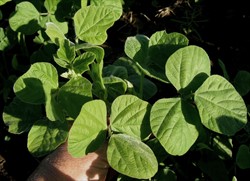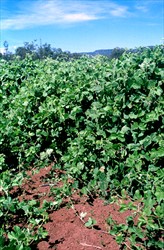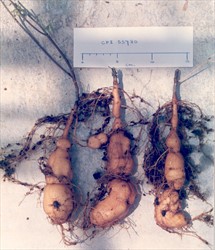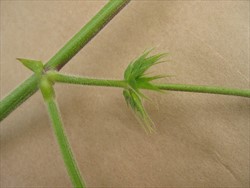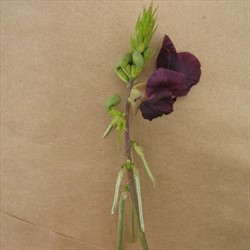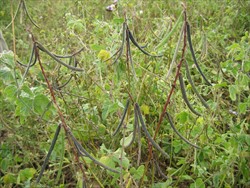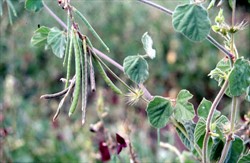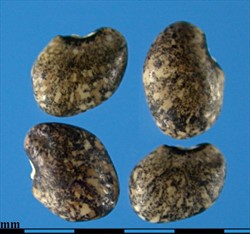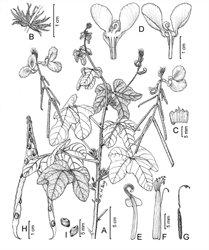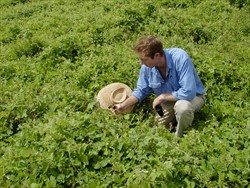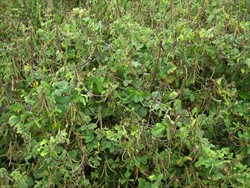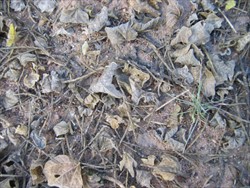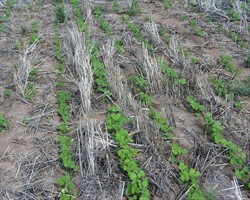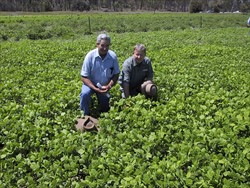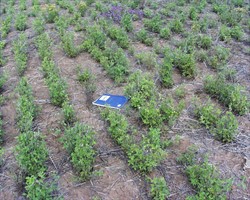Macroptilium bracteatum
Tropical Forages
Macroptilium bracteatum (Nees & Mart.) Maréchal & Baudet
Basionym: Phaseolus bracteatus Nees & Mart.
Family: Fabaceae (alt. Leguminosae) subfamily: Faboideae tribe: Phaseoleae subtribe: Phaseolinae.
Erect and somewhat trailing herbaceous perennial with pubescent stems to 100 cm tall; strong woody taproot. Leaves trifoliolate with stipules oval, 5–7.5 × 2.7–3.5 mm, petiole 1–4 cm long; leaflets 2.5–6 cm long and 1.7–3.8 cm wide, pubescent both sides; terminal leaflet symmetrical, somewhat pandurate with or without basal lobe either side; lateral leaflets ovate, assymetrical with single basal lobe, apex rounded, base obtuse. Peduncle glabrous, 10–15 cm long, and with a whorl of bracts close to the base; flowers in the upper third of the raceme, purplish-red in colour with small bracts at the base of each flower; calyx pubescent ca. 5 mm long, with 5 unequal teeth. Pod linear, 4–9 × 0.5–0.7cm with 9–19 seeds. Seeds 2.5–4 mm long and 3–4 mm in diameter, upper edge straight to concave, lower edge convex, brown, black or tan in colour, almost always mottled black, About 170,000 seeds per kg.
Similar species
M. bracteatum: whorl of bracts at the base of the peduncle.
M. atropurpureum: no whorl of bracts at the base of the peduncle.
English: burgundy bean
Latin America: feijão-de-rola (Brazil)
Native:
South America: Argentina (Salta, Jujuy, Formosa), Bolivia (La Paz, Santa Cruz), Brazil (Bahia, Minas Gerais, Rio Grande do Sul, São Paulo), Paraguay (Alto Paraguay, Amambay, Boquerón, Central, Chaco, Presidente Hayes), Peru (La Libertad), Venezuela (Anzoátegui).
Cultivated:
Australasia: Australia
Forage
M. bracteatum was selected for use as a short-term pasture plant on heavy textured alkaline soils in the subtropics. It replaces the more tropically adapted Clitoria ternatea in subtropical regions because of its greater tolerance of cooler temperatures. It is also an alternative to Medicago sativa in the subtropics.
Environment
It is largely used in ley systems to improve soil organic matter and improve the soil nitrogen status in preparation for subsequent grain crops.
Soil requirements
M. bracteatum inhabits high deciduous forest and disturbed vegetation within deciduous forest on limestone, caatinga and capoeira. It has been mostly collected from light to medium textured soils of near neutral pH, but with outliers of 4.5 and 8.5. Despite the range of light textured soils at the point of collection, M. bracteatum was selected for use on heavy textured soils which are invariably alkaline at and near the surface. Seed production in Queensland is conducted on moderately acid, duplex soils of granitic origin.
Moisture
Collected in areas with annual rainfall from 400 to 1,400 mm but is being used in subtropical environments with summer-dominant rainfall between 600 and 1,000 mm. Very drought tolerant and has persisted for at least 3 years on shallow clay soils with extreme mid-season droughts.
Temperature
M. bracteatum occurs over a wide temperature range having been collected between about 10 and 27°S , and 9 and 13° N, with average annual temperature extremes of 17.5 °C ( 1,260 m asl, 24° S) to 25 °C (270 m asl, 9° N). It germinates and commences growth at lower temperatures than many other tropical and subtropical legumes. If moisture is available, it germinates and commences regrowth some weeks earlier than C. ternatea in spring in the subtropics. In the higher latitude subtropics where early spring rains can often occur, this is one of its most valuable characteristics. In addition to its capacity to grow in cooler temperatures, M. bracteatum has been used successfully in pasture areas that typically have high summer temperatures (>35 ºC).
Light
Mostly grown in full sun.
Reproductive development
In the southern hemisphere, reproductive development usually commences in February after sowing in November with peak flowering in March and April, with about 50–90 days from sowing to flowering. As with M. atropurpureum, drought conditions intensify reproductive development so that mid-season drought can result in dense flowering and potentially high seed yields. In pastures carrying over from the previous year, flowering can commence in November and particularly if dry conditions occur mid-season, significant seed crops can develop.
Defoliation
M. bracteatum is extremely palatable and preferentially grazed. Consequently, grazing management in pastures with a high percentage of burgundy bean require periods of spelling. In the short term, individual plants have the capacity to regrow rapidly, although under longer term grazing, burgundy bean plant density usually declines, especially when a component of a grass dominant pasture. It is therefore essential to allow seed drop of both cultivars, but especially cv. Cadarga, for burgundy bean persistence. Although cv. Juanita is strongly perennial, cv. Cadarga is less so and relies far more upon seed production and seedling recruitment to persist.
Fire
No information available.
Guidelines for establishment and management of sown forages.
Establishment
M. bracteatum is easily established in prepared seed beds. Seed is relatively large and so can generally overcome soil surface crusting, a common feature of clay soils which have been cropped for several years. Recommended depth of sowing is about 3 cm although burgundy bean does re-establish well from fallen seed that is near the surface. Recently harvested seeds may have a high level of hardseededness, although this breaks down rapidly in the soil. Seed that has been harvested and stored should be checked for germinability prior to sowing, and, if it retains a high proportion of hard seed (e.g. >70%), mechanically scarified. Seedlings can grow extremely rapidly, although they compete poorly with some weeds species and well-established grasses. Urochloa panicoides, a common annual weed in agricultural land that has been cropped for long periods in the subtropical cropping regions of southern and central Queensland and northern New South Wales, can seriously reduce establishment if not controlled. Burgundy bean should be inoculated prior to sowing with a specific rhizobium strain such as CB 1717 (Australia). Recommended planting rate for uncoated seed is 2–5 kg/ha and 4–8 kg/ha for coated seed.
Fertilizer
Applications of 10–20 kg/ha P at sowing improve performance on old cropping soils. Molybdenum and sulphur may also be necessary in some situations.
Compatibility (with other species)
Burgundy bean forms good associations with grasses adapted to clay and clay loam soils, but because of its exceptional palatability, is difficult to maintain in pastures in significant amounts after 3–4 years. For this reason it is considered a short-term phase legume rather than a plant for permanent forages. The rapid growth and establishment of burgundy bean means that it can be used in combination with C. ternatea, which is comparatively low yielding in its first year but can persist for much longer.
Companion species
Grasses: Bothriochloa insculpta, Dichanthium aristatum, Megathyrsus maximus, Panicum coloratum.
Legumes: Clitoria ternatea, Stylosanthes seabrana.
Pests and diseases
No major problems although both cultivars can show leaf symptoms of bean mosaic virus. This appears to have little effect on productivity. It is susceptible to bean fly (Ophiomyia phaseoli), the green vegetable bug (Nezara viridula) and a range of flower-eating caterpillars in northern Australia. Insect control during flowering and seed set is critical in seed crops.
Ability to spread
Has the ability to spread through pod dehiscence and high seed yields but high palatability results in little spread outside of sown paddock.
Weed potential
Unlikely to have weed potential despite high seed yields. Hard seed breaks down far more rapidly than many other tropical and subtropical legumes, and the species is very palatable at all stages of maturity.
Nutritive value
While there is little information on nutritive value available, animal growth rates suggest burgundy bean produces high quality feed. Burgundy bean has been reported to have had leaf analysis of 3.2% N, 0.23% P and ADF of 29.3%, which was lower than that of butterfly pea but greater than for 'Seca' stylo (Stylosanthes scabra). Nutritive value of burgundy bean stems at the same time were 2.0% N, 0.22% P and ADF of 37.3% which was similar to those of butterfly pea (C. ternatea). In another measurement of forage quality, burgundy bean had 19.8% protein, less than the levels for lucerne (M. sativa), 22% and butterfly pea 24.5%.
Palatability/acceptability
Extremely palatable and selectively grazed.
Toxicity
None recorded. Burgundy bean does not cause bloat.
Dry matter
In good growing conditions and in pure or nearly pure swards, M. bracteatum can produce in excess of 5–8 t/ha/yr of DM in the sub-humid subtropics. Yields in the first year are often in this range if sufficient moisture is available. This high first year production is a major advantage over C. ternatea, Stylosanthes seabrana and Medicago sativa, all of which have considerably lower first year yields.
Animal production
Recorded liveweight gains have ranged from 0.40–0.9 kg/hd/day. This latter figure is from steers grazing burgundy bean dominant pastures for 71 days. Production from a grass-burgundy bean pasture and from grass only pastures grazed for the same period were 0.85 and 0.52 kg/hd/day respectively. Annual liveweight production per unit area for burgundy bean has been recorded as between 60 and 170 kg/ha.
2n = 22. Primarily self-pollinating with low level of outcrossing. Variety improvement has been through selection among wild types.
Seed maturity is not uniform and the seed pod shatters easily. Hence direct heading is feasible but inefficient in seed recovery. Suction harvesting is preferred. More seed is successfully recovered by suction harvesting even though the seed (smooth, naked and oval) is not ideally suited to this collection process. In commercial seed production, a simple, un-modified Horwood Bagshaw clover harvester has been used. Seed production from the two cultivars is similar at approx. 1 t/ha with 80–90% recovered from suction harvesting. Seed can be harvested 6–8 months after sowing.
Imazethapyr (Spinnaker®) can be used as pre-sowing/pre-emergent, post-sowing/pre-emergent or post-emergent herbicide (first or second trifoliate leaf). Pre-emergent application may have some effect on germination and post-emergent application may have some slight effect on seedlings though this is often short-term. Glyphosate (Roundup®) can be used post-sowing/pre-emergent to control weeds at planting. It has also been used at low application rates on mature plants to control emerging weeds. Herbicides used on other Macroptilium crops should be safe to use on M. bracteatum seed crops. These include the pre-emergence herbicide, trifluralin, and the post-emergence herbicides, acifluorfen, fluazifop-butyl and sethoxydim. Grass-selective herbicides are likely to be safe, but should be tested before broad-scale use.
- Suitable on a wide range of soil textures.
- Overcomes soil fertility decline in cropping soils.
- Germinates and grows under cooler (early spring) conditions (e.g. cf. butterfly pea ).
- Extremely palatable.
- Regenerates well from seed each year.
- Easily establishment on clay soils.
- Non-bloating.
- High palatability demands approriate management strategies when used in ley and short-term phase pastures.
- Specific rhizobium requirement.
- Susceptible to insect and virus damage.
- A short term perennial (or even an annual): persistence dependent on seedling recruitment.
Bell, L.W., Lawrence, J., Johnson, B. and Whitbread, A.M. (2012) Exploring short-term ley legumes in subtropical grain systems: production, water-use, water-use efficiency and economics of tropical and temperate options. Crop and Pasture Science 63:819–832. doi.org/10.1071/CP12190
Clem, R.L. (2004) Animal production from legume -based pastures in Southeastern Queensland. In: Whitbread, A.M. and Pengelly, B.C. (eds) Tropical legumes for sustainable farming systems in southern Africa and Australia. ACIAR Proceedings No. 115. Australian Centre for International Agricultural Research (ACIAR), Canberra, Australia. p. 136–144. aciar.gov.au/node/8436
Drewes, S.I. (1997) El género Macroptilium (Fabaceae) en la flora argentina. Boletin de la Sociedad Argentina de Botánica 32(2‒3):195‒216. http://botanicaargentina.org.ar/wp-content/uploads/2018/08/195-216002.pdf
Jones, R.M., Bishop, H.G., Clem, R.L., Conway, M.J., Cook, B.G., Moore, K. and Pengelly, B.C. (2000) Measurements of nutritive value of a range of tropical legumes and their use in legume evaluation. Tropical Grasslands 34:78–90. bit.ly/2WMzAqx
Pengelly, B.C. and Conway, M.J. (1998) The evaluation of tropical legumes for use in ley pastures in central and southern Queensland. Proceedings of the 9th Australian Agronomy Conference, Wagga Wagga, NSW, Australia, 20-23 July 1998. p. 163–166. bit.ly/2WVSzPI
Pengelly, B.C. and Conway, M.J. (2000) Pastures on cropping soils: Which tropical pasture legume to use? Tropical Grasslands 34:162–168. bit.ly/2yb8n6B
Pott, A. (2016) Macroptilium bracteatum (Feijão-de-rola). In: Vieira, R.F., Camillo, J. and Coradin, L. (eds) Espécies Nativas da Flora Brasileira de Valor Econômico Atual ou Potencial: Plantas para o Futuro ‒ Região Centro-Oeste. Secretaria de Biodiversidade, Ministério do Meio Ambiente, Brasília, DF, Brazil. p. 545‒549. https://bit.ly/2UMZUzo
Whitbread, A.M., Hall, C.A. and Pengelly, B.C. (2009) A novel approach to planting grass-legume pastures in the mixed farming zone of southern inland Queensland, Australia. Crop & Pasture Science 60(12):1147–1155. doi.org/10.1071/CP09058
Whitbread, A.M., Pengelly, B.C. and Smith, B.R. (2005) An evaluation of three tropical ley legumes for use in mixed farming systems on clay soils in southern in land Queensland, Australia. Tropical Grasslands 39:9–21. bit.ly/2UtHB2d
'B1' See 'Cadarga' and 'Juanita' below.
‘Cadarga’ (CPI 55769) Released in Australia (2000). Origin Brazil. An erect form; consistently high yielding in the first and second years on clay soils in the sub-humid subtropics. Although the highest yielding of lines tested at most evaluation sites, it can be affected by bean mosaic virus in wet years. It was proposed at the time that both ‘Cadarga’ and ‘Juanita’ be released and marketed as a composite. This composite is now being marketed as 'B1'.
'Garnet' F6 selection from a cross between Brazilian accessions 'MEF3544" and CPI 38732. This Australian cultivar was selected for having greater persistence than either 'Cadarga' or 'Juanita'.
‘Juanita’ (CPI 68892) Released in Australia (2000). Origin Minas Gerais, Brazil (19°26' S, 890 m asl, rainfall 1,500 mm). A decumbent form, relatively high yielding although not evaluated over as many sites as ‘Cadarga’. Does not appear to be affected by bean mosaic virus, and is more persistent than ‘Cadarga’. It was proposed at the time of release that both ‘Cadarga’ and ‘Juanita’ be released and marketed as a composite. This composite is now being marketed as 'B1'.
'Presto' A second F6 selection from a cross between Brazilian accessions 'MEF3544" and CPI 38732 (same parents as 'Garnet'). This Australian cultivar was selected for having greater persistence than either 'Cadarga' or 'Juanita'. In addition to its greater persistence, 'Presto' is an earlier maturing cultivar selected for environments with a shorted growing season.
CPI 27404, CPI 55756, CPI 55758, CPI 93100 Selected in Australia. These accessions, like 'Juanita', were collected in Brazil, and are similar to 'Juanita' being relatively persistent and trailing types rather than erect.
